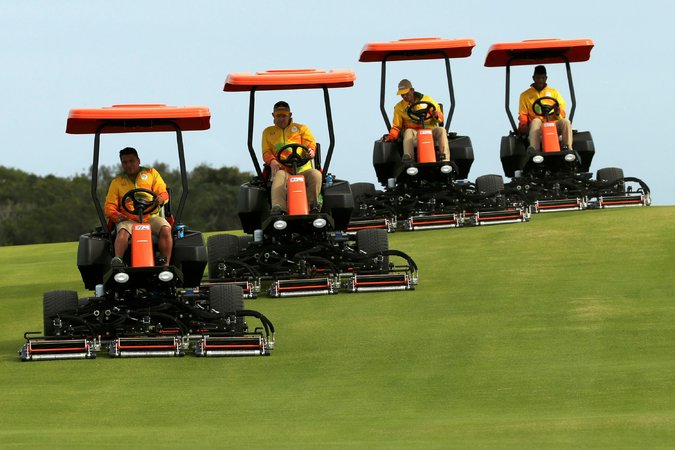As the Olympics continue to dominate the sports pages and the men’s golf competition finally started on Thursday the world is getting its first live action look at Gil Hanse’s creation.
The Olympic golf course at Barra da Tijuca was built especially for these games. Hanse beat out several big name golf course designers to land a very important but a very troubled assignment.
Adam Kilgore of the Washington Post gives us a Cliff Notes version of the many varied and frustrating issue that Hanse and the IOC faced during its seven year struggle to be completed.
The development of the course happened through years of aggravation and work, but they hope they will leave behind a means to grow golf in Brazil. The Olympic Golf Course will be Brazil’s first public golf course once the Games end, and organizers plan to create youth-development academies.
“The seven-year journey that took us here was one that had a lot of twists and turns to it, and was one that probably took longer than we expected it to,” Votaw said. “But now that we’re here and now that we’ve had the benefit of seven years of hindsight, all those twists and turns have brought us to where we think we have not only a great golf course, but also an iconic venue for these games.”
Once they could start working, they ran into the stumbling block of building next to an environmental reserve. Prosecutors sought to halt construction, claiming it had been sufficiently passed environmental impact tests. Olympic and golf officials say the course would provide environmental benefits. Critics disagreed, saying the course would encroach on the Atlantic Forest and endanger the Lutz tree iguana and the fluminense swallowtail butterfly.
The controversy may never be fully settled, but construction went on, the designers needed to adjust holes 13, 14 and 15 to conform with environmental standards.
By the time legal squabbles were settled, the IGF team had 2½ years to build the course and another year to grow it in. Votaw credited superintendent Neil Cleverly for producing grass in two growing seasons, a less-than-ideal time frame.
“He’s a real hero,” Votaw said. “I refer to him as the grass whisperer. He’s been able to do a lot for this golf course without a lot of resources.”
The finished product will be unveiled Thursday. It did happen without opponents or challenges. But it had never been done before, either. Golf returned to the Olympics, and a handful of people who spent every Friday on the phone for six years delivered it.
“It’s amazing honor,” Hanse said. “That’s the only that I can use. It’s been a wonderful opportunity for us, and we’re really proud of what we’ve produced.”
Building the course, as difficult as it was isn’t the only problem the IOC and the Brazilians faced. They had never put on a golf tournament before.
Each week we watch the PGA Tour, the LPGA and the European Tour stage tournaments all over the world that come off without a hitch. But the expertise needed to do just that has been acquired over decades of trial and error in tournament presentation.
The Brazilians had no experience in golf tournaments and the USGA, International Golf Federation and PGA Tour used their experts and resources to help Brazil to make golf’s return to the Olympics a success.
Last summer, a handful of Brazilian law enforcement officers traveled to Washington State on an unusual mission: to learn the etiquette and nuances of golf.
At the United States Open at Chambers Bay, the Brazilians were shown where they should stand on the course so they could protect players but not be struck with a ball or a club.
They were taught when they needed to remain in place so their movements did not distract golfers during their swings, and which ear pieces to use with their walkie-talkies so radio chatter did not disturb the players.
“You can take the world’s best security minds, but if they don’t understand golf, they are worth very little value at the venue,” said Don Donovan, the chief security adviser for the United States Golf Association, which hosted the Brazilian law enforcement officials for a tutorial at the event.
The trip to the Open was just one of dozens made over the past several years by Brazilian Olympic officials, organizers and security experts to golf tournaments in the United States, where Brazilians learned the basics of a game that has little following in their country.
There are only about 125 golf courses in Brazil, compared with roughly 14,500 in the United States. In 2009, a week after Rio de Janeiro was chosen as the host of the 2016 Games, golf was added to the Rio lineup, returning to the Olympics for the first time since 1904. But unlike the other finalists to host — Madrid, Tokyo and Chicago — Rio de Janeiro did not have a course that was suitable for a premier golf tournament.
“The great thing about golf is that pretty much every major city in the world has a golf course capable of hosting a golf tournament, but they picked out the one city that doesn’t,” said Ty Votaw, the vice president of the International Golf Federation.
Officials acknowledged that simply pulling off the men’s and women’s golf tournaments might be their biggest accomplishment, having navigated significant obstacles like building a course and training employees to manage it and run a tournament.
Indeed, it takes so much more than meets the eye to pull off a successful golf tournament. And with golf’s entry into the Olympics only assured through 2020 the Rio course and experience may have a big impact on whether or not golf lasts longer on the Olympic schedule.

